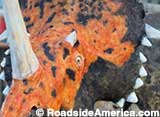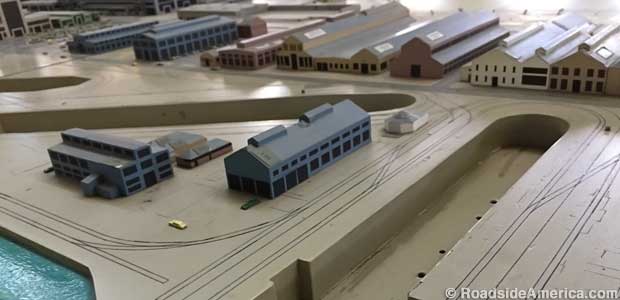
Drydock detail - Mare Island Naval Shipyard model.
Mare Island Naval Shipyard Museum (In Transition)
Vallejo, California
For 140 years, whenever the U.S. Navy needed warships, Mare Island Naval Shipyard was a Pacific production powerhouse. The Hammer Wall at the Mare Island Historical Park Museum visually nails it, commemorating ships built since 1854 with plaques made of tools and welded plates. Mare Island's shipyard completed 392 ships and 44 submarines, and repaired over 4,000 damaged vessels.
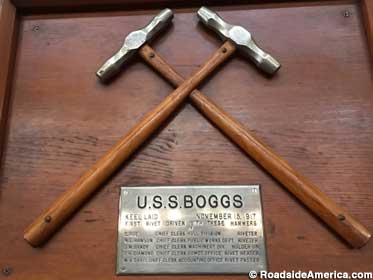
Part of the Wall of Hammers.
At the peak during World War II, the installation employed over 48,000 workers (the neighboring Richmond Merchant Marine shipyards also bulged with ship making activity). The Pacific coast's oldest permanent Naval installation was decommissioned in 1996 and its 5,200 acres are a mix of development projects, vacant officers' mansions, shuttered buildings, and preserved historical areas.
The museum in Building 46 tells the story of Mare Island's role in American naval presence in the Pacific. Visitors can examine several hundred artifacts in the museum's main gallery, from ship christening champagne bottles to diver suits for underwater hull work. Every display is informative, with details about military ship building, mixed with the arcana of workers and their crafts. There are rare and significant artifacts side by side with personal keepsakes from veterans' attics.
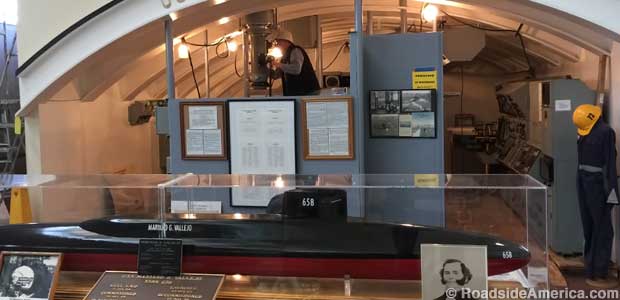
USS Vallejo model and control room.
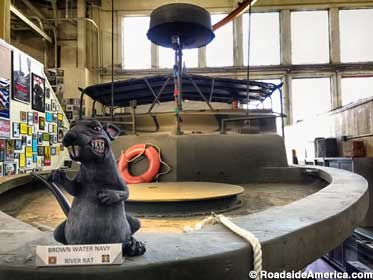
River Rat on a Vietnam era PBR.
Mare Island started as the Navy's first Pacific coast shipyard in 1854. The site was in San Francisco Bay, on a strip of land separated from the settlement of Vallejo by the Napa River. Its 19th century output evolved from wooden sloops-of-war to iron-hulled monitors.
The first aircraft carrier landing deck was made in 1910 on the USS Pennsylvania by stringing ropes every three feet, anchored by sand bags, across a wooden surface. The BB-44 USS California, a Tennessee Class battleship, was launched in 1919, damaged at Pearl Harbor, and re-floated three months later. Destroyer escorts were put together in the shipyards from sections built elsewhere. In 1930 Mare Island built its first submarine and finished 17 by the end of World War II; by 1959 it was building nuclear powered subs, and by 1961 had completed a nuclear sub carrying nuclear missiles.
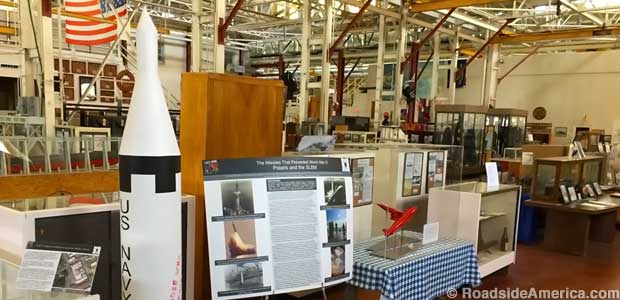
Polaris missiles prevented WWIII.
A few displays of note:
Vietnam War Patrol Boat, Riverine (PBR): After deteriorating outside for decades, Special Boat Unit 11 was restored in 2014 by volunteers. A "Brown Water" rubber rat stands defiantly on its bow. Sailors on the small tactical craft first deployed to Vietnam in 1966 were called "River Rats."
Submarine Control Room: A working periscope pokes out of the roof of Building 46, and swivels 360 degrees. You'll find it in a ground floor display of control room panels from the USS Mariano G Vallejo, a submarine built and launched in 1965 and decommissioned in 1994. The museum owns three hull penetrating periscopes from the Vallejo -- two sit on the floor. You can use the third to find the Polaris missile standing in a nearby park.
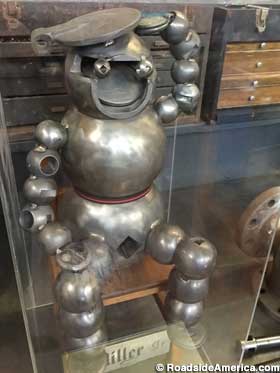
Miller Jr - Polisher of Navy balls.
Huge Mold Forms: Part of a mold form to make a propeller on site.
Man of Balls: Keep an eye out in the Machine Shop gallery for a small humanoid made of metal spheres (perhaps valve closers) with the label "Miller Jr - We polish the Navy's balls." A sign outlines the career of Jay Miller, who rose from his position in the machine shop to eventually become a "nuclear director" and "general foreman of section 60." Miller Jr might have been a retirement keepsake made by the shop: "During his tenure at Mare Island, Miller has had nine years of zero sick leave. And has received one belt buckle."
Cold War: Glass-topped cases present regalia and photos from every year of that quasi-conflict. There are medals and news snippets: "Mare Island outfits USS Halibut (SSN-587) to locate and photograph the K-129. The Top Secret operation is a complete success."The walls feature movie posters from the era: Strategic Air Command, Dr. Strangelove, Red Dawn, The Day After. Soviet propaganda shares space with photos of world leaders and civil defense advisories.
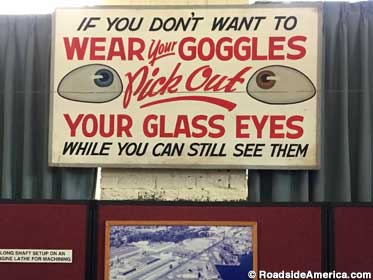
Hilarious safety sign.
Sail Loft: Along with its shipbuilding, Mare Island has a heritage of... military sewing. It started when women widowed during the Civil War needed a way to earn income. The government started a sewing arm to make and repair flags. The "Sail Loft" eventually involved hundreds of women (and men) in multiple buildings, and branched out to repairing life jackets, rubber boats and submarine lungs. They made as many as 80,000 flags a month; the famous flags raised on Iwo Jima's Mount Suribachi were stitched here.
Civil Rights: Mare Island was part of the 1944 Port Chicago Mutiny by African American sailors after a huge ammunition loading explosion at nearby Port Chicago killed 320 of their fellow sailors and civilians. Fifty men housed in Vallejo -- who had refused to board a ship to Mare Island to load ammunition -- were charged with mutiny, served some time and eventually freed; the legal battle resulted in broader public awareness of racism in the Navy, and eventual integration of the Navy's service ratings.
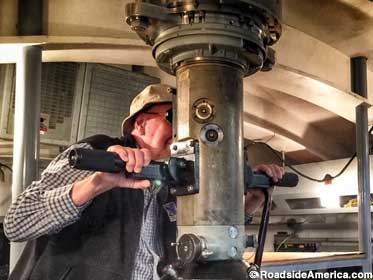
Working periscope for view from the roof.
USS Indianapolis: There's a special exhibit on the USS Indianapolis (CA-35) and the A-Bomb. During World War II, Mare Island is where the damaged cruiser had been repaired, and then outfitted with a secret delivery destined for Tinian. Under complete secrecy, A-Bomb components were processed and packaged in Building 627-A. Two Uranium-235 cores were sealed in a lead-lined metal container, then lashed to cleats tack-welded to the deck in the Admiral's Cabin (the captain of the Indianapolis was not told what the box contained -- only that if the ship was under extreme attack it should be thrown over the side). The new super weapon was delivered without incident, but on its equally covert return voyage, the Indianapolis was torpedoed by a Japanese sub and sunk.
Of the ship's original 1,197 sailors, only 317 outlived the explosions, sinking and sharks. There's an autographed beer bottle of a custom brew, "Survivors' Tale Pale Ale," made by the Mare Island Brewing Company for a 2015 reunion of Indianapolis survivors.
On the way out, we grabbed an island tour map, along with directions to the WWII era Mighty Midget -- "More firepower than any ship ever built for the U.S. Navy!"



